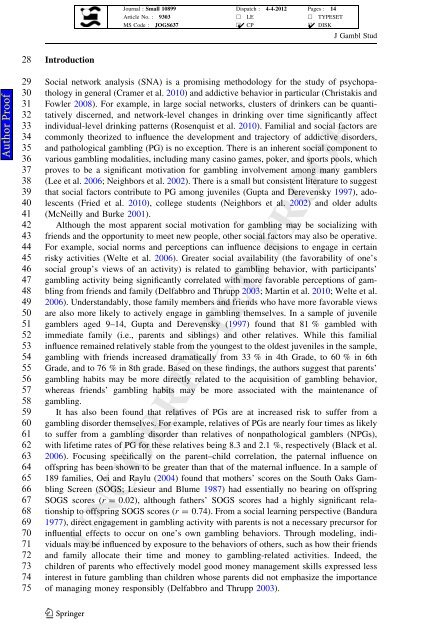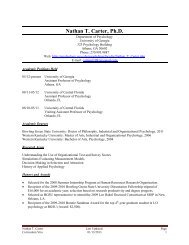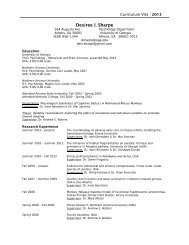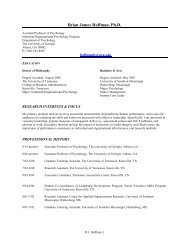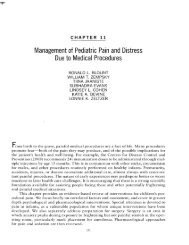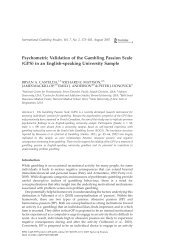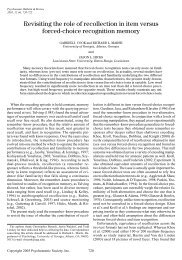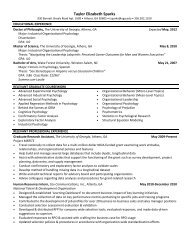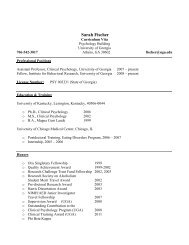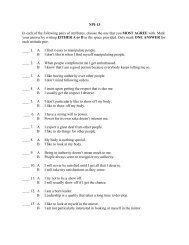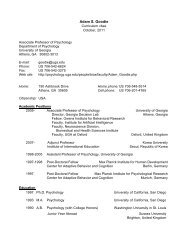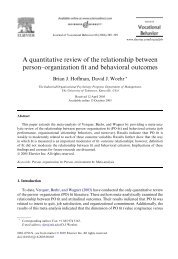Dear Author, Here are the proofs of your article. ⢠You can submit ...
Dear Author, Here are the proofs of your article. ⢠You can submit ...
Dear Author, Here are the proofs of your article. ⢠You can submit ...
You also want an ePaper? Increase the reach of your titles
YUMPU automatically turns print PDFs into web optimized ePapers that Google loves.
Journal : Small 10899 Dispatch : 4-4-2012 Pages : 14<br />
Article No. : 9303 h LE h TYPESET<br />
MS Code : JOGS637 h4 CP h4<br />
DISK<br />
J Gambl Stud<br />
28 Introduction<br />
<strong>Author</strong> Pro<strong>of</strong><br />
29 Social network analysis (SNA) is a promising methodology for <strong>the</strong> study <strong>of</strong> psychopa-<br />
30 thology in general (Cramer et al. 2010) and addictive behavior in particular (Christakis and<br />
31 Fowler 2008). For example, in large social networks, clusters <strong>of</strong> drinkers <strong>can</strong> be quanti-<br />
32 tatively discerned, and network-level changes in drinking over time signifi<strong>can</strong>tly affect<br />
33 individual-level drinking patterns (Rosenquist et al. 2010). Familial and social factors <strong>are</strong><br />
34 commonly <strong>the</strong>orized to influence <strong>the</strong> development and trajectory <strong>of</strong> addictive disorders,<br />
35 and pathological gambling (PG) is no exception. There is an inherent social component to<br />
36 various gambling modalities, including many casino games, poker, and sports pools, which<br />
37 proves to be a signifi<strong>can</strong>t motivation for gambling involvement among many gamblers<br />
38 (Lee et al. 2006; Neighbors et al. 2002). There is a small but consistent literature to suggest<br />
39 that social factors contribute to PG among juveniles (Gupta and Derevensky 1997), ado-<br />
40 lescents (Fried et al. 2010), college students (Neighbors et al. 2002) and older adults<br />
41 (McNeilly and Burke 2001).<br />
42 Although <strong>the</strong> most app<strong>are</strong>nt social motivation for gambling may be socializing with<br />
43 friends and <strong>the</strong> opportunity to meet new people, o<strong>the</strong>r social factors may also be operative.<br />
44 For example, social norms and perceptions <strong>can</strong> influence decisions to engage in certain<br />
45 risky activities (Welte et al. 2006). Greater social availability (<strong>the</strong> favorability <strong>of</strong> one’s<br />
46 social group’s views <strong>of</strong> an activity) is related to gambling behavior, with participants’<br />
47 gambling activity being signifi<strong>can</strong>tly correlated with more favorable perceptions <strong>of</strong> gam-<br />
48 bling from friends and family (Delfabbro and Thrupp 2003; Martin et al. 2010; Welte et al.<br />
49 2006). Understandably, those family members and friends who have more favorable views<br />
50 <strong>are</strong> also more likely to actively engage in gambling <strong>the</strong>mselves. In a sample <strong>of</strong> juvenile<br />
51 gamblers aged 9–14, Gupta and Derevensky (1997) found that 81 % gambled with<br />
52 immediate family (i.e., p<strong>are</strong>nts and siblings) and o<strong>the</strong>r relatives. While this familial<br />
53 influence remained relatively stable from <strong>the</strong> youngest to <strong>the</strong> oldest juveniles in <strong>the</strong> sample,<br />
54 gambling with friends increased dramatically from 33 % in 4th Grade, to 60 % in 6th<br />
55 Grade, and to 76 % in 8th grade. Based on <strong>the</strong>se findings, <strong>the</strong> authors suggest that p<strong>are</strong>nts’<br />
56 gambling habits may be more directly related to <strong>the</strong> acquisition <strong>of</strong> gambling behavior,<br />
57 whereas friends’ gambling habits may be more associated with <strong>the</strong> maintenance <strong>of</strong><br />
58 gambling.<br />
59 It has also been found that relatives <strong>of</strong> PGs <strong>are</strong> at increased risk to suffer from a<br />
60 gambling disorder <strong>the</strong>mselves. For example, relatives <strong>of</strong> PGs <strong>are</strong> nearly four times as likely<br />
61 to suffer from a gambling disorder than relatives <strong>of</strong> nonpathological gamblers (NPGs),<br />
62 with lifetime rates <strong>of</strong> PG for <strong>the</strong>se relatives being 8.3 and 2.1 %, respectively (Black et al.<br />
63 2006). Focusing specifically on <strong>the</strong> p<strong>are</strong>nt–child correlation, <strong>the</strong> paternal influence on<br />
64 <strong>of</strong>fspring has been shown to be greater than that <strong>of</strong> <strong>the</strong> maternal influence. In a sample <strong>of</strong><br />
65 189 families, Oei and Raylu (2004) found that mo<strong>the</strong>rs’ scores on <strong>the</strong> South Oaks Gam-<br />
66 bling Screen (SOGS; Lesieur and Blume 1987) had essentially no bearing on <strong>of</strong>fspring<br />
67 SOGS scores (r=0.02), although fa<strong>the</strong>rs’ SOGS scores had a highly signifi<strong>can</strong>t rela-<br />
68 tionship to <strong>of</strong>fspring SOGS scores (r=0.74). From a social learning perspective (Bandura<br />
69 1977), direct engagement in gambling activity with p<strong>are</strong>nts is not a necessary precursor for<br />
70 influential effects to occur on one’s own gambling behaviors. Through modeling, indi-<br />
71 viduals may be influenced by exposure to <strong>the</strong> behaviors <strong>of</strong> o<strong>the</strong>rs, such as how <strong>the</strong>ir friends<br />
72 and family allocate <strong>the</strong>ir time and money to gambling-related activities. Indeed, <strong>the</strong><br />
73 children <strong>of</strong> p<strong>are</strong>nts who effectively model good money management skills expressed less<br />
74 interest in future gambling than children whose p<strong>are</strong>nts did not emphasize <strong>the</strong> importance<br />
75 <strong>of</strong> managing money responsibly (Delfabbro and Thrupp 2003).<br />
UNCORRECTED PROOF<br />
123


